幸运飞行艇168官方开奖结果官网 Cloud
A free tier that’s actually useful
- 10k series Prometheus metrics
- Storage - 50GB logs, 50GB traces, 50GB profiles
- 500VUh synthetic testing
- 20+ Enterprise data source plugins
- From k8 to DB monitoring, 100+ pre-built solutions
- Incident Response Management & OnCall




























